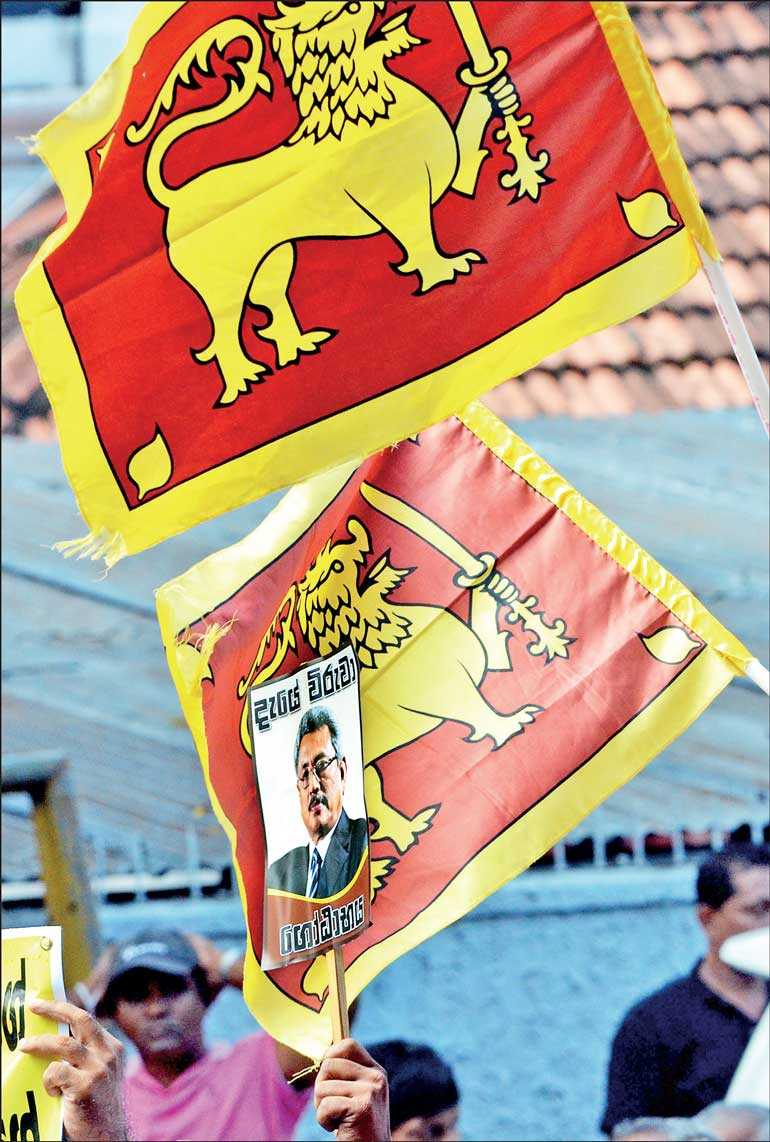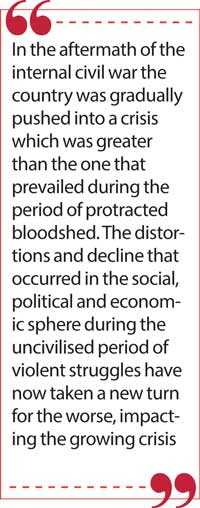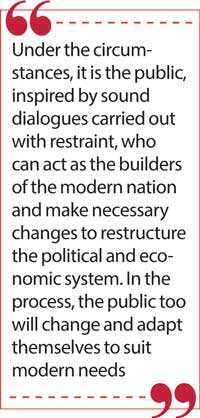Friday Jan 02, 2026
Friday Jan 02, 2026
Friday, 3 January 2020 00:10 - - {{hitsCtrl.values.hits}}

After ending the internal civil war, there were no killings of civilians or damage to property caused by terrorist attacks until the recent attack launched on Easter Sunday, by a group of extremist Muslim youths. 
But, in the aftermath of the internal civil war the country was gradually pushed into a crisis which was greater than the one that prevailed during the period of protracted bloodshed. The distortions and decline that occurred in the social, political and economic sphere during the uncivilised period of violent struggles have now taken a new turn for the worse, impacting the growing crisis.
To overcome this situation, it remained an essential condition to adopt socio-structural reforms to recreate the social, political and economic system. But for whatever reason, the Rajapaksa regime that won the internal civil war and the Yahapalana regime that succeeded the former did not resort to structural reforms necessary to reconstruct the social, political and economic system which had fallen into decay and degeneration.
Disregarding this urgent need and attempt to maintain the living standards at previous level by increasing the volume of foreign borrowings pushed the country into a complete bankruptcy.
Gotabaya Rajapaksa was elected president at a time when the country’s crisis had reached its climax and the country was on the brink of bankruptcy. The current crisis it is facing cannot be considered a phenomenon that is restricted only to a debt crisis; however it has become the major factor that determines the overall crisis.
Debt crisis
By the time Gotabaya Rajapaksa was elected as president, Sri Lanka’s outstanding foreign debt had risen to $ 52,313 million. The amount received from foreign commercial enterprises constitutes 50% of the total value of loans. Expenditure on foreign debt instalments and interest payable in 2017 could be $ 3,167 million and $ 4,188 million in 2018. It was $ 4,500 million for 2019; the total cost of foreign debt service payments is equal to 115% of the annual income of the Government. Failure to pay at least one of the loan instalments to foreign commercial enterprises will result in Sri Lanka being declared a bankrupt country.
Although the crisis in Sri Lanka was distinctly evident, neither the Government of Mahinda Rajapaksa nor the Yahapalana Government took it seriously and made necessary structural reforms. Instead, the debt crisis was ignored. This has resulted in depriving the country of the possibility of borrowing from other countries at concessionary interest rates, thereby compelling Sri Lanka to borrow at market interest rates or black market rates.
Currently, Sri Lanka is not in a position to pay the instalments and interest on foreign debt using internal economic strength of the country. In this backdrop that a large portion of the loan instalment has to be procured from foreign commercial establishments.
Under the circumstances, if we are driven to pay at black market rate of interest instead of the normal market rate, inevitably, it will exacerbate the Sri Lankan debt crisis in a new way. But, the Sri Lankan Government does not seem to be paying urgent and serious attention to overcome the terrible crisis it is facing at the moment.
Moreover, it has also not shown that it has a sustainable and practical vision for that. So much so, the attention of the Government, Opposition parties and the general public is focused on the forthcoming Parliamentary Election.
The impact that the increase in the rate of interest even by one single decimal point payable on loans obtained in millions of dollars can make on economy is enormous. The gravity of this situation will be further aggravated if the present ranking of Sri Lanka’s credit rating is dropped down to the level of DCCC in the event we fail to take practical action to resolve the debt problem. Such a situation, if it occurs, will be the worst that can happen as it will inevitably push Sri Lanka into a state of complete insolvency.
Sri Lanka now stands on the verge of a terrible abyss. The political leaders who are supposed to steer the nation and the religion are either in a mood of excitement and joy caused by the overwhelming victory of the Presidential Election or in a state of bewilderment caused by the defeat of the election. They do not seem to perceive the real situation, the predicament the country is facing. They are fully absorbed in the upcoming carnival of the Parliamentary Election.
The most important thing to realise at this moment is that Sri Lanka has reached a level in which the country is compelled to come to terms with the situation and abandon the life of abundance and comfort and be prepared to adopt a life of austerity. There is no magic wand that the Government can wave to do away with the crisis. But, if necessary, it can take certain practical and feasible measures to ease off the burden of the people.
The rural farmer community has the greatest potential to ease the sufferings of the people in a period of hardships such as this. Therefore, the country should be directed towards adopting accelerated and practical measures in making a rapid and comprehensive growth in the rural agriculture. If the damage caused by wild animals to rural economy could be reduced and brought to a minimum, it will certainly help, resulting in a big boost and a rapid growth in rural agriculture.
There are two measures the Government can take in this respect. One is to reduce the density of population of monkeys and rilavus by 80%. This move alone will make a significant boost in rural agriculture, including home gardening; it will also help increase, at least to double the income generated by rural agricultural sector.
The next important thing to do, along with this, would be to grant the farmers the right to hunt wild animals such as wild boar, porcupines and peacock that damage agriculture and allow the farmers to possess, transport and sell the meat of those animals. These measures will lead to a significant increase in the output of rural agricultural production and a significant increase in the income of the farmers.
Dhal/lentils, chillies and milk
The importance of dhal in the field of Sri Lankan cuisine is enormous. So much so, life without love is compared to a hotel without a dhal curry. The cost of importing dhal is as high as $ 1,600 million per annum.
Although dhal (lentil) cannot be grown in Sri Lanka, it would be possible to grow thora parippu, a local variety of dhal that grows on Sri Lanka’s soil. The peeled green gram also known as moong dal is more delicious than lentils. If the entire requirement of green gram and thora parippu is produced locally, import of dhal to Sri Lanka can be cut off completely, thereby making a saving of $ 1,600 million in foreign exchange spent on importation of dhal per annum.
It is only about 15% of the total requirement of chillies that is produced in Sri Lanka. Approximately 50,000 metric tons of dried chillies are imported per annum and the cost incurred is Rs. 10,000 million. As per the estimates of the Department of Agriculture, the income that can be earned from one acre of paddy stands at Rs. 40,000 while that of chillies is as much as Rs. 333,373. Regrettably, due to abandonment of research on chilli seeds, except for finding varieties for raw chillies, it has not been possible to develop a proper variety for dried chillies.
However, if the research is conducted using genetic technology, making it a matter of national priority, it would not be difficult to develop, perhaps in less than a year, a variety of green chillies that can resist the leaf blight and produce a generous crop capable of making one kilo of dried chillies with four kilos of green chillies.
If the old-fashioned methods of chilli cultivation are modernised by replacing them with greenhouse systems, despite its initial cost being high, it would be possible to generate comparably higher income whilst at the same time making it a pioneering opportunity of shifting Sri Lanka’s agricultural sector into a modern phase from its current state of stagnation.
Sri Lanka spends $ 400 million on import of milk powder per annum. Since Sri Lanka produces 45% of its milk requirement, it will not be a big burden for the country even if the milk powder imports are completely stopped. However, it will not be difficult to make Sri Lanka self-sufficient from milk, if there is a consistent national policy on cattle farming.
Cattle farming is not economically viable unless it is pursued for the production of both milk and meat. India does not consume beef, but it is one of the major beef exporters in the world. If Sri Lanka does not consume beef, it must be allowed to be carried out at least as an export industry. It is only then that it would be possible to make cattle farming an economically viable business and the country self-sufficient in milk.
Fuel and motor vehicles
The annual cost of importing motor vehicles to Sri Lanka is $ 1,573.5 million. Import of all types of motor vehicles can be banned for a period of five years. Though it can have a drop in tax revenues of the Government, it can make a big relief on the problem of balance of payment. It can also reduce the cost of fuel.
Presently, Sri Lanka has too many motor vehicles. Therefore, a policy that regulates the quantum of vehicles used will certainly take the country to a level where the optimum use of motor vehicles are made while at the same time boosting the technical sector of the automobile industry in the country.
Fuel cost can be considered as the largest component of import costs. Annual fuel import cost of Sri Lanka is $ 4,151 million. Countries like Brazil, the United States, the European Union and India have adopted a policy of mixing 10% to 15% ethanol or alcohol to petrol. This blended mixture of petrol and alcohol is considered as a type of an eco-friendly fuel.
Brazil has produced two models of motor cars capable of being driven only by ethanol. Why can’t Sri Lanka adopt a similar policy? Wouldn’t it be possible to use locally produced illicit alcohol called kasippu as a source of automobile fuel for this purpose? I think there is a good potential for that.
It is important that we should, emulating the experience of other countries, look into the possibility of using kasippu as a source of fuel and conduct research to find out what changes are needed to make for kassipu which at present is being manufactured at cottage level as an illicit brew.
If kasippu can be converted into a viable alternative to mix with petrol by identifying the changes need to be made for it, it would be possible to save $ 650 million spent on petrol imports. By doing so, this industry which is being carried out at domestic level as an illicit operation can be regularised and made a major contributor to the economy of the country.
It can be converted into an industry that will add a higher value to the country’s economy than the amount added by paddy production. The income that could be generated by this project will amount to Rs. 117,500 million. Consequently, the income flow to the rural economy will go up by the same amount.
Turning disaster into a blessing
The present crisis can be made an opportunity to convert rural agriculture into an export market without limiting it to paddy farming and field crops only. I hope to talk about how it can be done separately in a future article. For the time being, I must say that by implementing the proposals described above alone it would be possible to save $ 4,205 million in foreign exchange which is equal to the annual premium Sri Lanka has to pay for debt servicing.
We can be wiser and practical in proportion to the challenge the country is facing, it would be possible to turn even a great disaster into a blessing. The catastrophic breakdown of the entire system of the country can be transformed into an opportunity to modernise the country and move it forward with an enhanced vigour and momentum.
The country can be orientated towards such a massive transformation, only if Sri Lanka has the necessary discipline to make a proper investigation into the causes that pushed the country into its present state of failure and the wretchedness. At the time of independence Sri Lanka enjoyed a shining position among Asian countries. At that time, most Asian countries that have currently achieved massive development were lagging far behind Sri Lanka.
Notwithstanding the strength and potential it had initially, which other countries did not have, Sri Lanka has become a stagnant, inefficient and failed state afflicted with rampant corruption and incessant bloodshed. The main reason for this can be described as an outcome of its failure to build the modern nation without leaving room for the recognition of caste discrimination and occasional outbreaks of clashes on ethnic and religious lines.
What many countries in the world which had encountered unfortunate predicaments like this had done to overcome the situation had been to direct the country towards adopting a people’s constitution aimed at creating a socio-political and economic environment conducive to restore the country and uplift them into a better level.
It can be described as a direct democratic opportunity extended, temporarily to the public within the framework of democratic rule to exercise their sovereignty to recreate the entire system after having looked into all aspects of governance whilst at the same time limiting the monopoly power enjoyed by the political elites in the past, who have a history of unsuccessful rule behind them.
Under the circumstances, it is the public, inspired by sound dialogues carried out with restraint, who can act as the builders of the modern nation and make necessary changes to restructure the political and economic system. In the process, the public too will change and adapt themselves to suit modern needs.